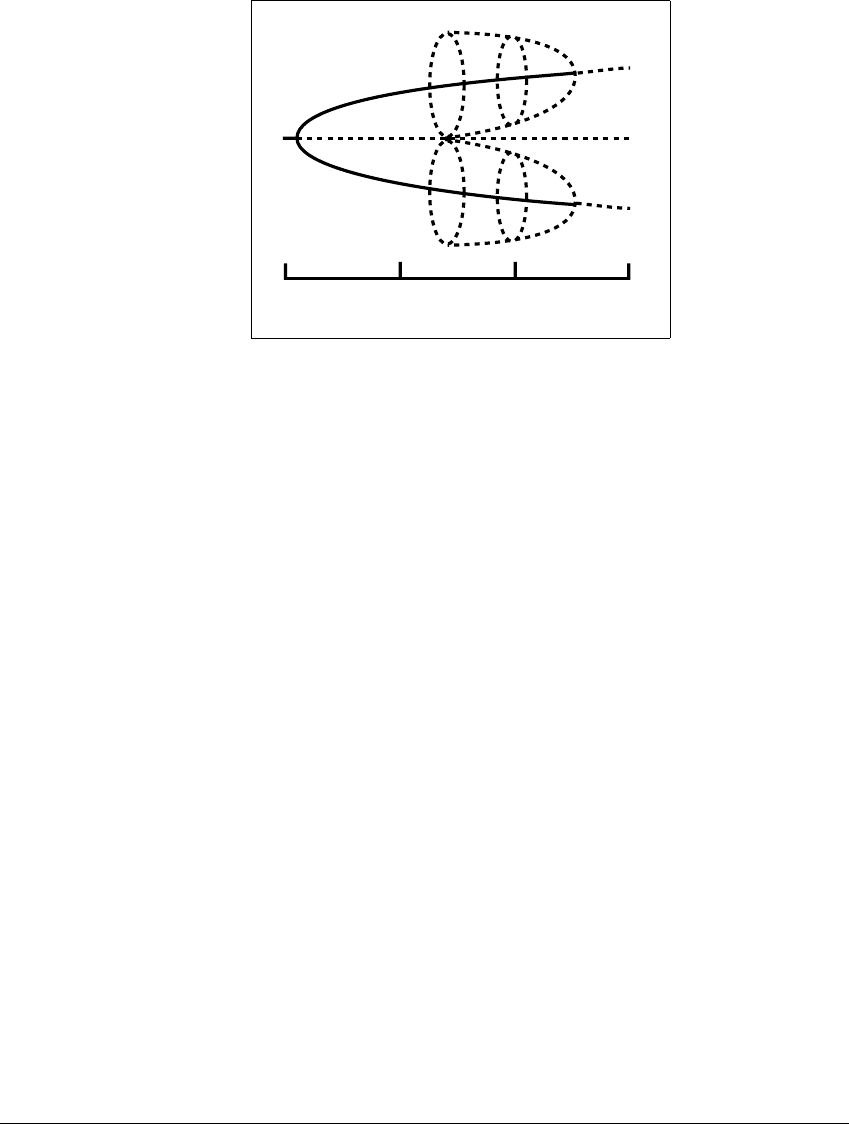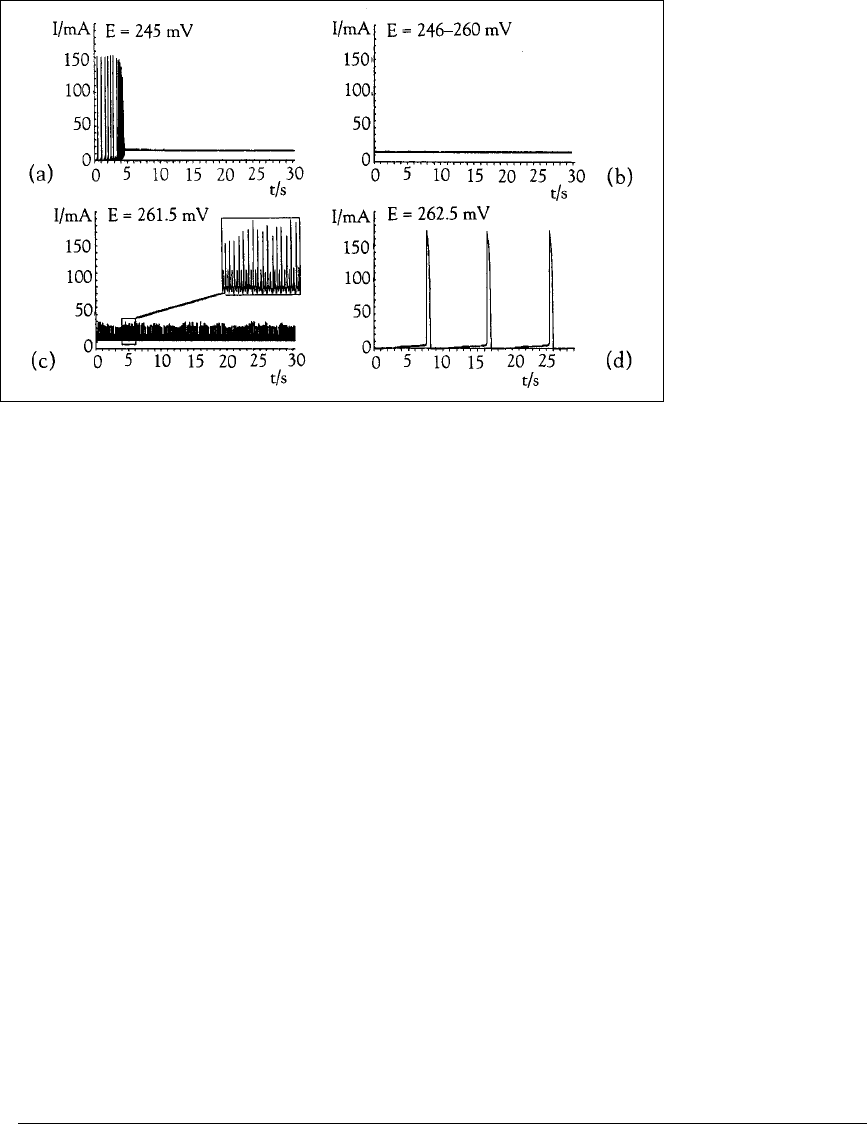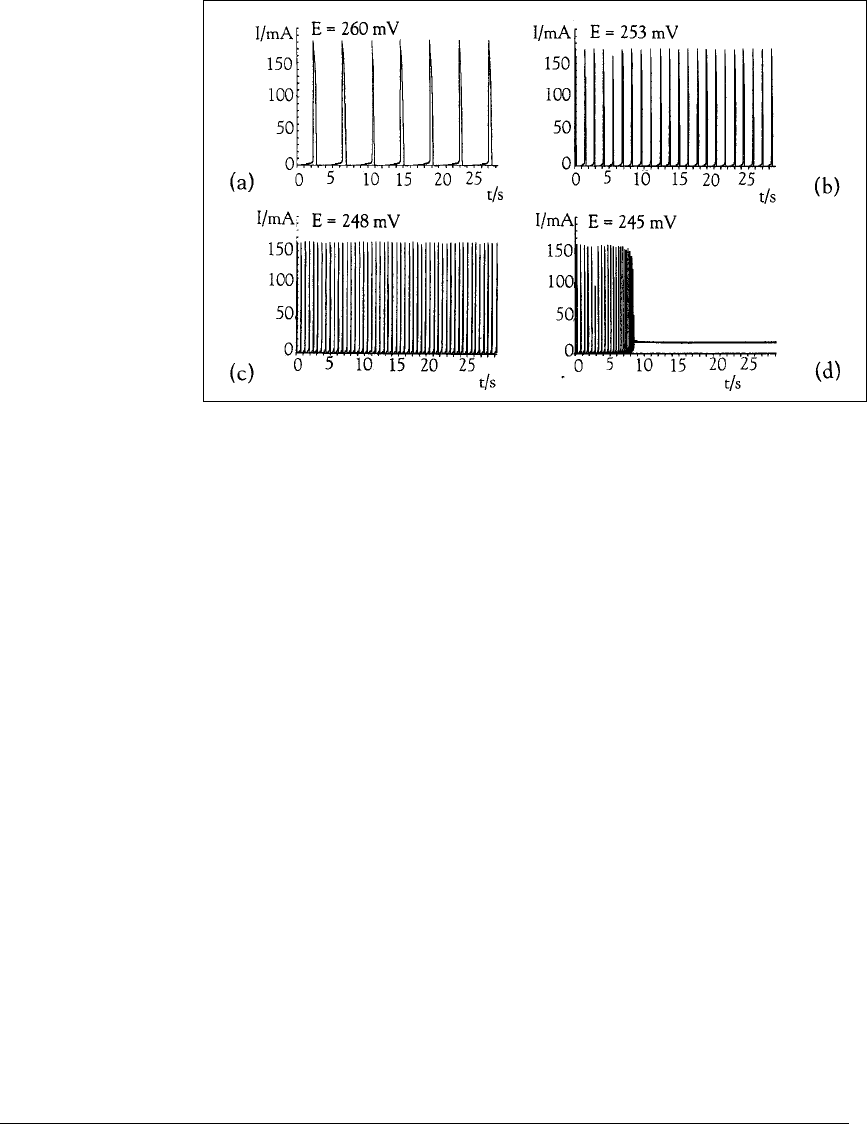Alligood K., Sauer T., Yorke J.A. Chaos: An Introduction to Dynamical Systems
Подождите немного. Документ загружается.


B IFURCATIONS
0 10 20
30
Figure 11.26 A Hopf bifurcation in the Lorenz equations.
A bifurcation diagram of the Lorenz equations for
⫽ 10, b ⫽ 8 3, and 0 ⱕ r ⱕ 30,
is shown. At r ⫽ 1, the origin goes from stable to unstable, as two attracting
equilibria bifurcate. Paths of stable orbits are indicated by solid curves, while paths
of unstable orbits are represented by dashed curves and circles. A subcritical Hopf
bifurcation occurs at r ⫽ 24.74, at which point two families of unstable orbits
bifurcate simultaneously as the two attracting equilibria lose their stability. Typical
trajectories in computer simulations then move toward the chaotic attractor, first
observed to occur at the crisis value r ⫽ 24.06.
increase and diverge to
⬁
. The behavior at r ⫽ 13.926 is quite complicated—this
is the value for the onset of chaos in the Lorenz equations.
There are chaotic trajectories but no chaotic attractor for 13.926 ⬍ r ⬍
24.06. A chaotic attractor is observed to first occur near r ⫽ 24.06. See (Kaplan
and Yorke, 1979) for specifics of this estimation. At exactly r ⫽ 24.06, a typical
trajectory undergoes a long transient before being attracted by one of the sinks,
as shown in Figure 9.5. Therefore, throughout the parameter range 24.06 ⬍ r ⬍
24.74, the Lorenz system possesses three attractors: one apparently chaotic and
two which are not, the attracting equilibria.
490

C HALLENGE 11
☞ C HALLENGE 11
Hamiltonian Systems and the Lyapunov
Center Theorem
W
E HAVE SEEN that the stability of an equilibrium is often determined by
the Jacobian of the vector field. Theorem 7.18 states that when the eigenvalues of
the Jacobian all have negative real part, the equilibrium is asymptotically stable.
When a single eigenvalue has positive real part, the equilibrium is unstable. What
happens when the eigenvalues are pure imaginary (have real part equal to zero)?
In general, an equilibrium is called a center if the Jacobian of the vector field has
only pure imaginary eigenvalues.
We want to investigate the behavior of a system near a center. We can start
to answer the question by looking at the linear case. For a two-dimensional linear
system with eigenvalues ⫾bi, the origin is an equilibrium, and all other solutions
are periodic orbits of period 2
b. For a nonlinear system, it turns out that a
center can be attracting, repelling, or neither. However, there is an important
type of nonlinear system for which we can say that the behavior is stable near a
center.
In Chapter 7, we saw examples of conservative systems such as the un-
damped pendulum. Trajectories of conservative systems are constrained to one
energy level. In other words, energy remains constant along a solution. The
set of equations that govern the motion of the pendulum is one example of a
general class of differential equations called Hamiltonian systems. Specifically,
for a smooth function H : ⺢
2
→ ⺢, called the Hamiltonian function or energy
function, Hamilton’s equations are:
˙
x ⫽
H
y
˙
y ⫽⫺
H
x
. (11.19)
Theorem 11.26 guarantees that in a Hamiltonian system, an equilibrium
with pure imaginary eigenvalues will have a neighborhood containing periodic
orbits. Your job in Challenge 11 is to construct a proof of this theorem in the
two-dimensional case.
Theorem 11.26 (Lyapunov Center Theorem.) Assume that 0 is a center
equilibrium of the Hamiltonian system (11.19) and that ⫾bi are simple eigenvalues of
491

B IFURCATIONS
the Jacobian A of the vector field at 0. Assume further that no other eigenvalue of A is
an integer multiple of bi. Then each neighborhood of the center contains periodic orbits,
whose periods approaches 2
b as they approach the center.
The strategy is to show that the theorem is a consequence of the Hopf Bifur-
cation Theorem. To do this, you will build a one-parameter family of differential
equations for which (11.19) is the member at a ⫽ 0. Then show that a Hopf bi-
furcation occurs at a ⫽ 0, but that no member of the family for a ⫽ 0 has periodic
orbits. The only remaining possibility is that the periodic orbits emanating from
the Hopf bifurcation point must all occur for a ⫽ 0, that is, they are periodic
orbits surrounding the center.
Step 1 To warm up, verify that (11.19) implies that
˙
H(v) ⫽ 0, where
v ⫽ (x, y)and
˙
H(v) ⫽
H
x
dx
dt
⫹
H
y
dy
dt
.
Therefore the Hamiltonian H is a constant of the motion.
These equations can be generalized to higher even dimensions in which case
H is defined on ⺢
2n
. Then for (x
1
,...,x
n
,y
1
,...,y
n
) 僆 ⺢
2n
, the two equations
of system 11.19 become the 2n equations dx
i
dt ⫽
H
y
i
,i ⫽ 1,...,n, and
dy
i
dt ⫽⫺
H
x
i
,i⫽ 1,...,n.
Now we assume the Hamiltonian satisfies the hypotheses of the two-
dimensional Lyapunov Center Theorem; that the origin 0 is an equilibrium,
and that ⫾bi are eigenvalues of the Jacobian at 0. Embed the Hamiltonian system
in a one-parameter family of differential equations:
˙
x ⫽ a
H
x
⫹
H
y
˙
y ⫽ a
H
y
⫺
H
x
, (11.20)
where a is a scalar parameter. Notice that the original Hamiltonian system occurs
at a ⫽ 0.
Step 2 Show that 兵(a, 0):a 僆 ⺢其 is a path of equilibria.
Using the notation gradH for the gradient of H, and letting J ⫽
01
⫺10
, we can rewrite the system (11.20) in the following matrix form:
˙v ⫽ (aI ⫹ J)gradH(v).
492

C HALLENGE 11
Step 3 Show there are no periodic (nonequilibrium) orbits of (11.20) for
a ⫽ 0. [Hint: Let (x
a
(t),y
a
(t)) be a solution of (11.20). Verify that (dH dt)(x
a
(t),
y
a
(t)) ⫽ a|gradH|
2
.]
The goal now is to prove that (11.20) has a Hopf bifurcation at a ⫽ 0,
in which case all bifurcating periodic orbits must occur at a ⫽ 0 (the original
Hamiltonian). To that end, we need to show that a path of eigenvalues of the
linearized system crosses the imaginary axis at ib when a ⫽ 0.
Let f
a
(v) ⫽ (a ⫹ J)gradH(v). Then D
v
f
a
(0) ⫽ (aI ⫹ J)M, where M is
the 2 ⫻ 2 matrix of second partial derivatives of H (with respect to the phase
variables) evaluated at v ⫽ 0.
Step 4 Show that M is a nonsingular symmetric matrix, and that its in-
verse M
⫺1
is also.
Step 5 Show that
˙v ⫽ JMv (11.21)
is a Hamiltonian system with Hamiltonian function E(v) ⫽
1
2
v
T
Mv.
Step 6 Let c(a) ⫹ d(a)i be a path of eigenvalues of D
v
f
a
(0) ⫽ (aI ⫹ J)M.
Conclude from Steps 3 and 4 that if a ⫽ 0thenc(a) ⫽ 0.
Step 7 Show that if
is an eigenvalue of (aI ⫹ J)M, then ⫺
is an
eigenvalue of (⫺aI ⫹ J)M. [Hint: If (aI ⫹ J)M ⫺
I is singular, so is M
⫺1
[(aI ⫹
J)M ⫺
I]
T
M.]
Step 8 Use Steps 6 and 7 to conclude that the eigenvalues of D
v
f
a
(0)
cross the imaginary axis at ⫾bi when a ⫽ 0.
Step 9 Use the weak version of the Hopf Bifurcation Theorem in Remark
11.22 to show that there are periodic orbits of period approaching 2
b in every
neighborhood of the origin.
493

B IFURCATIONS
E XERCISES
11.1. Find a saddle-node bifurcation and a period-doubling bifurcation for f
a
(x) ⫽
a sin x.
11.2. Find a period-doubling bifurcation for g
a
(x) ⫽⫺x(a ⫹ x). For what parameter
value a does the period-two orbit itself go through a period-doubling?
11.3. Find a period-doubling bifurcation for f
a
(x) ⫽ x
3
⫺ ax.
11.4. Let
T (a, x) ⫽
ax if x ⱕ
1
2
a(1 ⫺ x)ifx ⬎
1
2
Draw the tent map bifurcation diagram for (a, x)in[0, 2] ⫻ [0, 1].
11.5. Find all saddle-node and period-doubling bifurcations of fixed points for the fol-
lowing maps.
(a) f
a
(x) ⫽ a ⫹ ln x, for x ⬎ 0.
(b) f
a
(x) ⫽ a ⫺ ln x, for x ⬎ 0.
(c) f
a
(x) ⫽ a ln x, for x ⬎ 0.
(d) f
a
(x) ⫽ a ⫹ x ⫺ e
x
11.6. Let f
a
(x
1
,x
2
) ⫽ (ax
1
⫺ x
2
2
,x
1
⫹ ax
2
). Show that the family f
a
has two paths of
fixed points (paths in a). Find parameter values at which ⫹1 is an eigenvalue of
D
v
(f) evaluated along these paths. Explain what happens to the stability of the
fixed points at these parameter values.
11.7. Find the saddle-node and period-doubling bifurcations of fixed points for the
H
´
enon map f
a
(x, y) ⫽ (a ⫺ x
2
⫹ 0.3y, x).
11.8. Give an example of a one-parameter family of scalar maps f and a fixed point
x of
f
a
such that f
a
(x) ⫽⫺1 and there is not a period-doubling bifurcation at (a, x).
11.9. (Period-doubling bifurcation.) In this exercise, a specific condition on derivatives
is shown to guarantee that period-doubling bifurcations are isolated. Assume that
f
a
(x) ⫽ f(a, x) is smooth (partial derivatives of order at least 2 exist and are
continuous). Let (
a, x) be a fixed point of f with
df
dx
(a, x) ⫽⫺1. Since this value
is not ⫹1, there is a path of fixed points (a, x(a)) for a near
a with x(a) ⫽ x.
(a) Show that if
d
2
f
dadx
(
a, x) ⫹
1
2
d
2
f
dx
2
(a, x)
df
da
(
a, x) ⫽ 0, (11.22)
then
d
2
f
dadx
(a, x(a)) ⫽ 0.
494

E XERCISES
(b) Show that (11.22) implies there is a neighborhood of (a, x) in which there
are no other fixed points (a
ⴱ
,x
ⴱ
) satisfying the period-doubling condition
df
dx
(a
ⴱ
,x
ⴱ
) ⫽⫺1.
11.10. Unlike a saddle node orbit, a period-doubling bifurcation can be either supercrit-
ical or subcritical. In other words, the bifurcation orbit for a family of scalar maps
can be either attracting or repelling. In this problem, two coefficients in the Taylor
series expansion for the map at the bifurcation value are shown to determine the
stability of the bifurcation orbit.
(a) Let f(x) ⫽ x ⫹ cx
3
. Show that the fixed point x ⫽ 0 is attracting if c ⬍ 0
and repelling if c ⬎ 0.
(b) Assume that x ⫽ 0 is a fixed point of a scalar map g and that g
(0) ⫽⫺1.
(In this exercise there is no parameter: g is the map at the bifurcation parameter
value.) Let
g(x) ⫽⫺x ⫹ bx
2
⫹ dx
3
⫹ higher order terms.
Show that 0 is attracting if b
2
⫹ d ⬎ 0 and repelling if b
2
⫹ d ⬍ 0.
11.11. For a real number c, define the one-parameter family f
a
(x) ⫽ (x ⫺ a)(2x ⫺ 3a) ⫹
x ⫹ c. For what values of c is there a bifurcation in this family? Describe the
bifurcations and list the bifurcation points (
a, x). Note that c ⫽ 0 corresponds to
generic bifurcations while c ⫽ 0 corresponds to a special one.
11.12. Denote by ˙v ⫽ f(v) the system which gives the supercritical Hopf bifurcation
shown in Figure 11.23. Now draw the corresponding two diagrams for ˙v ⫽⫺f(v).
Which type of Hopf bifurcation is this?
11.13. Consider the Chua circuit equations as defined in (9.6), with parameters set as in
Figure 9.10. Use Exercise T11.21 to find the parameter c
3
for which the system
undergoes a Hopf bifurcation.
11.14. Let
˙
x ⫽ r
c
x
⫺ d
⫹ ax ⫺ bxy
˙
y ⫽ r
b ⫺
a
y
⫺ cy ⫹ dxy (11.23)
where a, b, c, and d are positive constants, and r is a fixed parameter and x and y
are scalar variables, x ⫽ 0,y⫽ 0. Notice that when r ⫽ 0, the system models a
simple predator-prey interaction, as we described in Chapter 7.
(a) Show that (x, y) ⫽ (
c
d
,
a
b
) is an equilibrium for all r.
(b) Show there is a Hopf bifurcation at (
c
d
,
a
b
)whenr ⫽ 0.
(c) Show that all bifurcating periodic orbits occur at r ⫽ 0.
495

B IFURCATIONS
☞ L AB V ISIT 11
Iron + Sulfuric Acid −→ Hopf Bifurcation
T
HIS EXAMPLE of electric current oscillations in an electrochemical reac-
tion exhibits a subcritical Hopf bifurcation and hysteresis. These dynamical ideas
are fairly new compared to the long history of electrochemistry. The first elec-
trochemical system showing periodic orbits dates from G. Fechner in 1828, who
found an oscillating current caused by the competing forces of depositing and
dissolving of silver on an iron electrode placed in a silver nitrate solution.
The experiment shown here was designed to explore oscillatory phenomena
in the dissolving of iron in a sulfuric acid solution. A 99.99% iron rod with a
diameter of 3 mm is lowered into 200 ml of the acid. When a potential difference
is applied, the current of the electrochemical system is a measure of the overall
reaction rate between the electrode surface and the electrolytic solution. The
behavior of the current as a function of time shows considerable complication at
certain parameter settings. The so-called electrodissolution problem is far from
completely understood, due to the large number of coupled chemical reactions
involved.
The electrical potential applied to the electrode is used as a bifurcation
parameter in this experiment. Figure 11.27 shows a small sample of the interest-
ing dynamical phenomena in this reaction. Parts (a)–(d) of the figure show the
measured current (in milliamperes) as a function of time (in seconds), for four
different settings of the potential. The potential increases from (a) to (d). Figure
11.27(a) shows a short transient followed by a constant current, which continues
for the slightly higher potential in (b). In Figure 11.27(c), small irregular oscilla-
tions have developed, which seem aperiodic. Another small change in potential
leads to clear periodic oscillations of larger amplitude in (d). Apparently, a Hopf
bifurcation has occurred.
The time series in Figure 11.28 are from the same electrochemical experi-
ment, except that in this case, the voltage parameter is decreased from part (a)
to (d). Viewed together, the behaviors shown in Figures 11.27 and 11.28 can be
Sazou, D., Karantonis, A., and Pagitsas, M. 1993. Generalized Hopf, saddle-node infinite
period bifurcations and excitability during the electrodissolution and passivation of iron
in a sulfuric acid solution. Int. J. Bifurcations and Chaos 3: 981–997.
496

L AB V ISIT 11
Figure 11.27 Current time series for increasing parameter.
Moving to the right along the solid a-axis in the subcritical Hopf bifurcation of
Figure 11.25. (a) Potential is 245 mV. Transient yields to steady state. (b) 246–260
mV show steady state. (c) 261.6 mV, oscillations of small amplitude and period.
(d) 262.6 mV, nine-second oscillations.
interpreted as being the result of a subcritical Hopf bifurcation, as seen earlier in
this chapter.
Referring to Figure 11.25, for large values of the parameter, the periodic
orbit is the only attractor, and so it is globally attracting. As the parameter
moves to the left, the trajectory continues its periodic behavior even as the Hopf
bifurcation point is passed. Only after the saddle-node bifurcation point is passed,
on the far left of Figure 11.25, does the system relax to the steady state. Thus
hysteresis is seen. As the parameter increases along the negative x-axis, we see
one system behavior, while when the parameter is decreased through the same
parameter range, we see a different behavior.
Figure 11.28 demonstrates this type of hysteresis in the electrochemical
experiment. The voltage parameter is decreased from part (a) to part (d), crossing
the same parameter range that was crossed in an increasing manner in Figure
11.27. This time, as expected for a subcritical Hopf bifurcation with hysteresis,
periodic behavior is recorded until the voltage is decreased sufficiently, to pass the
saddle-node bifurcation point. After this value, orbits are attracted to the steady
state as shown in Figure 11.28(d).
497

B IFURCATIONS
Figure 11.28 Current time series for decreasing parameter.
Moving to the left along the upper (periodic) branch of Figure 11.25. (a) Potential
difference is 260 mV, periodic orbit. (b) 253 mV, periodic. (c) 248 mV, periodic.
(d) 245 mV, periodic orbit disappears, convergence to steady state after transient.
The small aperiodic oscillations that are apparent in Figure 11.27(c) are
unexplained by this theory and may be due to the presence of “noise” near the
Hopf bifurcation point. The theory of the Hopf bifurcation is developed for finite-
dimensional differential equations, and applies to the extent that this experiment
is well-modeled by them. Model inaccuracies may matter at some times more than
others. In particular, they may be magnified at parameter values where stability is
in flux, such as in Figure 11.27(c), thereby limiting the explanatory power of the
model.
498

C HAPTER T WELVE
Cascades
C
ASCADES OF period-doubling bifurcations have been seen in the great majority
of low-dimensional systems that exhibit chaotic behavior. A “cascade” appears
as an infinite sequence of period-doubling bifurcations. A stable periodic orbit is
seen to become unstable as a parameter is increased or decreased and is replaced
by a stable periodic orbit of twice its period. This orbit in turn becomes unstable
and is replaced by a new stable orbit with its period again doubled, and the process
continues through an infinity of such period-doubling bifurcations.
The goal of this chapter is to study properties of cascades, and to understand
what general conditions imply their existence. We continue the study of bifur-
cations from Chapter 11 and develop a picture of families of orbits as connected
sets, where the primary bifurcations are period doublings and saddle nodes. Our
499
